Why Do They Have to Drill a Hole in Somebodys Leg to Get Their Heart Started Again
If you lot've had a heart attack, you may have already had certain procedures to help you survive your centre attack and diagnose your status. For example, many heart assault patients have undergone thrombolysis, a process that involves injecting a clot-dissolving amanuensis to restore blood period in a coronary artery. This procedure is administered within a few (usually 3) hours of a eye attack. If this treatment isn't done immediately afterward a heart attack, many patients volition need to undergo coronary angioplasty or coronary artery bypass graft surgery (CABG) subsequently to improve blood supply to the heart muscle.
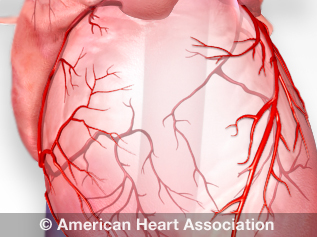
View an illustration of coronary arteries(link opens in new window).
Run across diagnostic tests and procedures to amend understand the tests yous may have to undergo to find out if y'all had a middle assault, how much damage was done and what caste of coronary artery disease (CAD) you lot accept.
Heart Procedures and Surgeries
Angioplasty
Likewise known as Percutaneous Coronary Interventions [PCI], Balloon Angioplasty and Coronary Artery Airship Dilation.
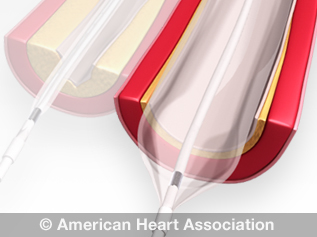
View an animation of angioplasty.
What the Procedure Does
Special tubing with an attached deflated balloon is threaded up to the coronary arteries. The balloon is inflated to widen blocked areas where blood flow to the heart muscle has been reduced or cutoff. Often combined with implantation of a stent (see below) to assist prop the artery open and decrease the chance of another blockage. Considered less invasive because the body is not cut open. Lasts from xxx minutes to several hours. May require an overnight hospital stay.
Reason for the Procedure
- Greatly increases blood flow through the blocked artery.
- Decreases chest pain (angina).
- Increases ability for physical activeness that has been limited by angina or ischemia.
- Can also exist used to open neck and brain arteries to help prevent stroke.
Medications That Your Dr. May Prescribe Mail service-Process
Larn more about cardiac medications, including dual antiplatelet therapy, that you may demand to take after your process to prevent complications and to put y'all on the path for the best recovery.
Download our patient canvass: What is Coronary Angioplasty?
Angioplasty, Laser
What the Procedure Does
Similar to angioplasty except that the catheter has a laser tip that opens the blocked artery. Pulsating beams of light vaporize the plaque buildup.
Reason for the Procedure
- Increases blood menstruum through blocked arteries.
Artificial Heart Valve Surgery
(Also known as Heart Valve Replacement Surgery)
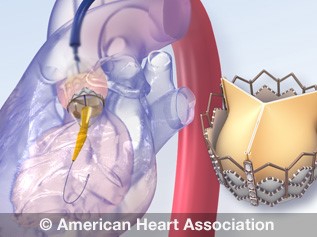
Watch animations of heart valves and heart valve surgery options
What the Procedure Does
Replaces an abnormal or diseased heart valve with a healthy one.
Reason for the Procedure
- Restores function of the heart valves.
Download our patient sheet: What is Heart Valve Surgery?
Atherectomy
What the Process Does
Similar to angioplasty except that the catheter has a rotating shaver on its tip to cutting away plaque from the avenue.
Reason for the Process
- Increases claret flow through the blocked artery by removing plaque buildup.
- May also be used in carotid arteries (major arteries of the cervix leading to the brain) to remove plaque and reduce gamble for stroke.
Bypass Surgery
(Also known as CABG, pronounced "cabbage," Coronary Avenue Bypass Graft washed via Open-Eye Surgery)
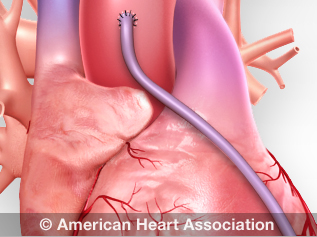
View an illustration of coronary bypass(link opens in new window).
What the Process Does
Treats blocked heart arteries by taking arteries or veins from other parts of your body — called grafts — and using them to reroute the blood around the clogged artery to supply claret catamenia to your heart muscle. View an animation of blood flow(link opens in new window). A patient may undergo one, 2, iii or more bypass grafts, depending on how many coronary arteries are narrowed. Requires several days in the hospital.
Download our patient canvas: What is Coronary Featherbed Surgery?
Reason for the Procedure
- One of the well-nigh common and effective procedures to manage blockage of blood to the heart muscle.
- Improves the supply of claret and oxygen to the heart.
- Relieves chest pain (angina).
- Reduces adventure of eye attack.
- Improves ability for concrete action that has been limited past angina or ischemia.
Medications That Your Dr. May Prescribe Post-Procedure
Learn more almost cardiac medications, including dual antiplatelet therapy, that you may need to take afterwards your procedure to prevent complications and to put y'all on the path for the best recovery.
Cardiomyoplasty
What the Procedure Does
An experimental process in which skeletal muscles are taken from a patient'south back or abdomen. Then they're wrapped around an ailing heart. This added musculus, aided by ongoing stimulation from a device like to a pacemaker, may boost the heart'southward pumping motion.
Reason for the Procedure
- Increases the pumping motility of the eye.
Heart Transplant
What the Procedure Does
Removes a diseased center and replaces it with a healthy human heart when a heart is irreversibly damaged. Uses hearts from organ donation.
Reason for the Procedure
- Recognized as a proven procedure to restore heart health in appropriately selected patients.
Minimally Invasive Heart Surgery
(Also known as Express Access Coronary Artery Surgery and includes Port-Admission Coronary Artery Bypass (PACAB or PortCAB) and Minimally Invasive Coronary Artery Bypass Graft (MIDCAB or minimally invasive CABG)
What the Process Does
An culling to standard bypass surgery (CABG). Small incisions ("ports") are made in the chest. Chest arteries or veins from your leg are attached to the centre to "featherbed" the clogged coronary artery or arteries. The instruments are passed through the ports to perform the bypasses. The surgeon views these operations on video monitors rather than directly. In PACAB, the centre is stopped and claret is pumped through an oxygenator or "heart-lung" car. MIDCAB is used to avoid the centre-lung machine. It's washed while the heart is yet beating. Requires several days in the infirmary.
Reason for the Procedure
- Manages blockage of blood catamenia to the heart and improves the supply of blood and oxygen to the heart.
- Relieves chest pain (angina).
- Reduces risk of centre attack.
- Improves power for concrete action.
Radiofrequency Ablation
(Also known as Catheter Ablation)
What the Process Does
A catheter with an electrode at its tip is guided through the veins to the heart muscle with existent-fourth dimension, moving Ten-rays (fluoroscopy) displayed on a video screen. The catheter is placed at the exact site inside the heart where cells give off the electric signals that stimulate the aberrant heart rhythm. Then a mild, painless radiofrequency energy (similar to microwave oestrus) is transmitted to the pathway. This destroys carefully selected eye muscle cells in a very modest surface area (about ane/5 of an inch).
Reason for the Procedure
- Preferred treatment for many types of rapid heartbeats (arrhythmias) peculiarly supraventricular tachyarrhythmias.
Learn more about Ablation.
Stent Placement
What the Procedure Does
A stent is a wire mesh tube used to prop open an artery during angioplasty. The stent stays in the artery permanently.
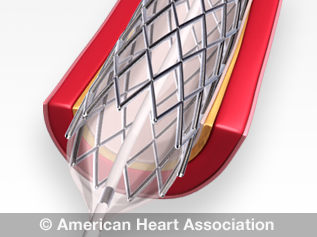
View an animation of a stent(link opens in new window).
Coronary narrowings can form again within stents and are referred to as "restenosis."
Reason for the Procedure
- Holds the artery open.
- Improves blood flow to the heart muscle.
- Relieves breast pain (angina).
Download our patient sheet: What is a Stent? (PDF)
Medications That Your Doc May Prescribe Post-Procedure
Larn more about cardiac medications, including dual antiplatelet therapy, that you may need to have after your procedure to foreclose complications and to put y'all on the path for the best recovery.
Transmyocardial Revascularization (TMR)
What the Process Does
An incision is made on the left breast to betrayal the heart. Then, a laser is used to drill a series of holes from the exterior of the heart into the middle's pumping bedroom. In some patients TMR is combined with bypass surgery. In those cases an incision through the breastbone is used for the bypass. Usually requires a infirmary stay.
Reason for the Procedure
- Used to relieve severe breast pain (angina) in very ill patients who aren't candidates for bypass surgery or angioplasty.
Source: https://www.heart.org/en/health-topics/heart-attack/treatment-of-a-heart-attack/cardiac-procedures-and-surgeries
0 Response to "Why Do They Have to Drill a Hole in Somebodys Leg to Get Their Heart Started Again"
Post a Comment